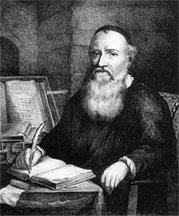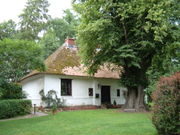Menno's life
Menno Simons was born in the Frisian town of Witmarsum (The Netherlands). It was not until the beginning of the twentieth century that historians agreed that Menno must have been born in January 1496. It was Karel Vos, Menno's first real biographer, who cited Menno's reply to Gellius Faber, in which Menno writes: "It was in the year 1524, in my twenty-eighth year …" Thus, Menno's year of birth was 1496 and not 1492 as was commonly believed until then. For example, the Dutch celebrated the fourth centennial of Menno's birth in 1892.
Little is known about Menno's childhood and home. His parents were probably dairy farmers. Menno may have received his training in a nearby monastery. He had some knowledge of the church fathers, knew Latin and a little Greek but no Hebrew.
 Menno was consecrated a
priest at Utrecht, in 1524. For twelve years (1524-1536) he served as a
parish priest, first for seven years in his father's village Pingjum,
later for five years in Witmarsum. He would later write about how he
and his fellow priests lived an easy going life, spending their time
"playing cards, drinking, and in diversions as, alas, is the fashion
and usage of such useless people".
Menno was consecrated a
priest at Utrecht, in 1524. For twelve years (1524-1536) he served as a
parish priest, first for seven years in his father's village Pingjum,
later for five years in Witmarsum. He would later write about how he
and his fellow priests lived an easy going life, spending their time
"playing cards, drinking, and in diversions as, alas, is the fashion
and usage of such useless people".
In 1525, probably influenced by the sacramentarian ideas of the early reformers, Menno began to doubt whether the bread and wine of the mass actually changed into the body and blood of Christ (the Roman Catholic doctrine of transsubstantiation). Tormented by doubts he decided to seek help in Luther's writings and the New Testament. As a typical priest of his time, he had never read the Scriptures before, accepting the teaching that the church was infallible. "I had not touched them in my life, for I feared if I should read them, I would be misled."
In the Bible Menno could not find any evidence of the doctrine of transsubstantiation. "I did not get very far in it before I saw that we had been deceived". He concluded that the meaning of the Lord's supper was symbolic.
While reading the Scriptures Menno was led to doubt another cornerstone of the church: the cardinal doctrine of infant baptism. He was amazed to hear that Sicke Freerks Snijder, a tailor, had been executed in Leeuwarden for having himself rebaptized. "It sounded strange to me to hear of a second baptism." The death of this "pious and devout hero" was reason for Menno to turn again to the Scriptures, searching for a biblical foundation for the practice of infant baptism. The fact that he could not find any direct reference to infant baptism in the Bible convinced Menno that believers' baptism was the true Christian practice.
Apart from the Bible Menno also read the works of the church fathers, humanist Desiderius Erasmus, and protestant leaders such as Martin Luther, Martin Bucer and Heinrich Bullinger. During these years Menno regarded himself as an "evangelical preacher" but he remained within the church. He accepted a call to become pastor of his home church in Witmarsum, where he remained until 1536. In the meantime the Anabaptist movement in the Netherlands came under the influence of people like Jan Matthijs and Jan van Leyden. In 1534 Matthijs and his followers took over the German city of Münster where they wanted to establish a 'New Jerusalem'. The Münsterites remained in the city for several months but were defeated by the bishop's army on June 25, 1535. Inspired by the attempts of the Münsterites, a group of about 300 people tried to take over the Olde Klooster, a monastery near Bolsward. In the subsequent siege most were killed in action or captured and executed. Among the casualties were Peter Simons, who may have been Menno's brother, and several members of Menno's congregation.
In reaction to the aborted attempt to take over the Olde Klooster, Menno wrote his first tract: Een gantz duidelijcke end klaer bewijs ... Tegens de grouwelijck end grootste blaspehmie van Jan van Leyden (Against the Blasphemy of Jan van Leyden). To Menno 'Olde Klooster' was a decisive moment. He could not help feeling responsible and regarded the reveolutionaries as sheep without a shepherd. "I saw that these zealous children, although in error, willingly gave their lives ... for their doctrine and their faith. And I was one of those who had disclosed to some of them the abominations of the papal system."
Menno felt he had to make a deliberate choice between the authority of the church and that of the Scriptures. In a public statement on January 30, 1536 he told of his new commitment to Christ. Soon after that Menno was baptized by Obbe Philips, at that time the leader of the non-resistant Anabaptists in the Netherlands.
When about a year later Menno was asked to become an elder of the Anabaptist movement, he agreed reluctantly. He knew his talents were limited but he also realized the need among the Anabaptists, who "erred as do harmless sheep which have no shepherd". From then on Menno dedicated his life to the preaching of the gospel and the shepherding of the brethren and became the most prominent leader of the peaceful Anabaptists in the Netherlands and Northwestern Germany. Pronounced a heretic he was in constant danger, hounded by authorities, and continually had to seek refuge from persecution. In 1544 he wrote that he "could not find in all the countries a cabin or hut in which my poor wife and our little children could be put up in safety for a year or even half a year".
 Menno
had a price of two thousand guilders on his head and those who gave him
food or shelter, read any of his books or even spoke with him paid for
their kindness with their lives. Tjaard Renicx of Kimswerd for example,
was executed in January 1539 for having sheltered Menno. In June 1549
Klaas Jans was executed because Menno had stayed overnight in his house.
Menno
had a price of two thousand guilders on his head and those who gave him
food or shelter, read any of his books or even spoke with him paid for
their kindness with their lives. Tjaard Renicx of Kimswerd for example,
was executed in January 1539 for having sheltered Menno. In June 1549
Klaas Jans was executed because Menno had stayed overnight in his house.
Menno always managed to remain one step ahead of his enemies and died a natural death in 1561 in Wüstenfelde, Schleswig-Holstein (Germany), 25 years after his withdrawal from the Catholic Church. He was buried in his own garden.